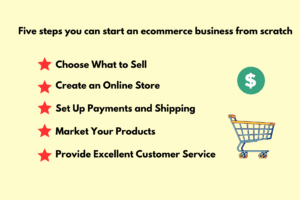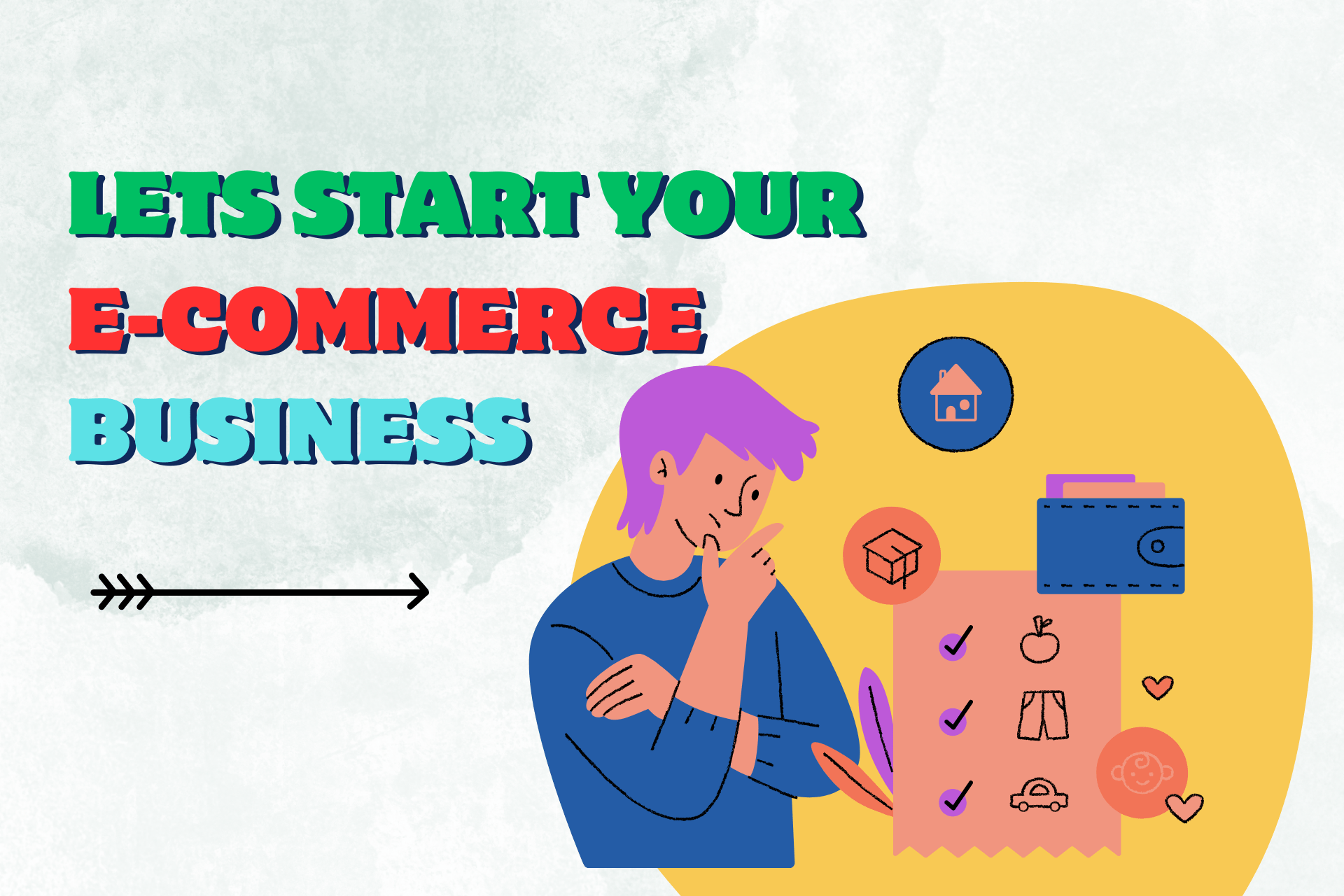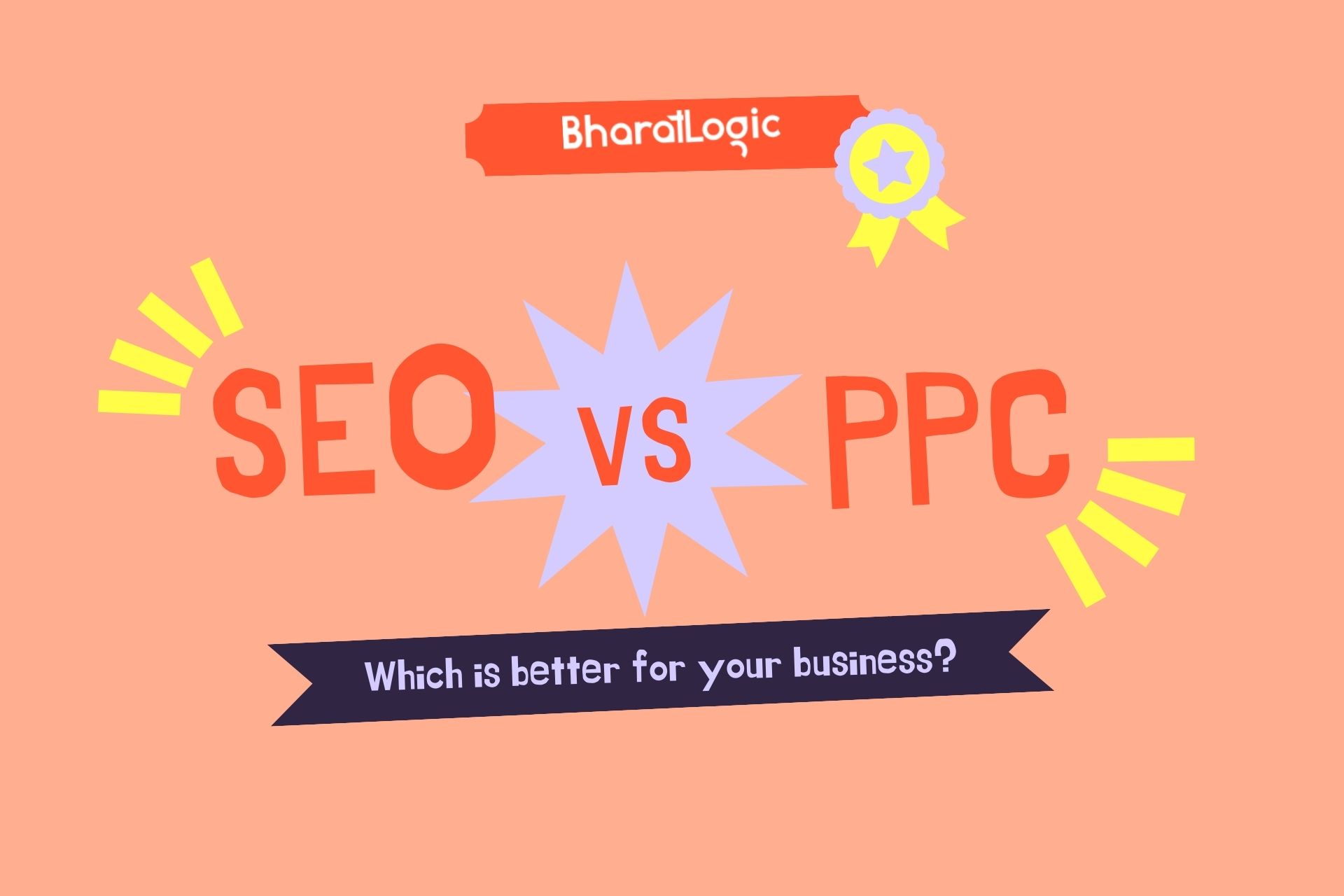How to start your own Ecommerce Business
Many of us dream about starting a regular business and some of us had started , but the regular business with regular ideas had reached local or smaller consumers. Now imagine you got a consumer from out of your local reach here comes Ecommerce business at play.
To start your own Ecommerce business, first, figure out what you want to sell and who you want to sell it to. Make a plan that lays out your business goals, target audience, and how you’ll market your products.
Take care of legal stuff like choosing a business structure, getting the necessary permits, and setting up a business bank account. Pick a catchy business name, register a matching domain, and set up a website using platforms like Shopify or WooCommerce. Decide how you’ll get your products (make them, dropship, or buy from suppliers) and keep tabs on your inventory. Make sure your website is safe for customers to use by setting up secure payment options and reliable shipping.
Once your site is live, market your products using social media, SEO, and email. Pay attention to customer service and use analytics to keep improving. Stay flexible and be ready to expand your business as it grows.

Let’s break it down into even simpler steps:
▶ Decide What to Sell:
Think about what you’re passionate about or what people need. Your product could be anything from handmade crafts to gadgets.
▶ Make a Simple Plan:
Jot down your goals, like how much money you want to make and who you want to sell to. This doesn’t need to be super formal.
▶ Get Legal Basics Sorted:
Choose a name for your business and make sure no one else is using it. Register it and check if you need any permits.
▶ Set Up Your Online Shop:
Use easy platforms like Shopify, where they guide you through making your online store. No need to be a tech genius!
▶ Decide How to Get Products:
You can either make stuff yourself, buy from others, or have a company send products when you make a sale (called drop shipping).
▶ Make Buying Easy:
Set up simple ways for people to pay you online. PayPal and credit cards are good options.
▶ Sort Out Shipping:
Decide how you’ll send products to customers. You can use local post offices or delivery services.
▶ Tell People About Your Shop:
Use social media like Instagram or Facebook to show off your products. You don’t need a big budget for this.
▶ Be Nice to Customers:
Answer their questions and sort out any problems they have. Happy customers can become repeat customers!
▶ Keep an Eye on Things:
Look at simple website stats to see what’s popular. This can help you make smarter decisions.
▶ Grow Slowly:
As you get more comfortable, you can think about adding more products or trying new ways to reach customers.
Remember, you don’t have to have everything perfect from the start. Just take it step by step, and you’ll learn as you go!
In these Five steps you can start an ecommerce business from scratch

It’s essential to understand that starting an ecommerce business involves identifying what you want to sell, creating an online store, setting up payment and shipping processes, marketing your products, and providing excellent customer service. So, let’s explore the five key steps to kickstart your e-commerce venture.
1. Choose What to Sell
2. Create an Online Store
3. Set Up Payments and Shipping
4. Market Your Products
5. Provide Excellent Customer Service

Choose What to Sell:
To pinpoint a successful product, start with your passions or areas of expertise. Conduct thorough market research using tools like Google Trends and Amazon Best Sellers to identify trending products.
Analyze your target audience’s needs and preferences. Utilize keyword research tools such as SEMrush or Google Keyword Planner to understand search volumes and popular terms.
If you’re hesitant about handling inventory, consider drop shipping platforms like Oberlo or AliExpress. Evaluating the competition in your chosen niche will help you differentiate your products and find a unique selling proposition.
Create an Online Store:
Choose an e-commerce platform aligned with your business goals. Shopify is user-friendly, WooCommerce integrates seamlessly with WordPress, and Magento offers advanced customization. Design a visually appealing website using tools like Canva or Adobe Spark for product images and graphics. Ensure mobile responsiveness for your site using Google’s Mobile-Friendly Test. Streamline the buying process with clear product descriptions, intuitive navigation, and a secure checkout.
Set Up Payments and Shipping:
Integrate secure payment gateways like Stripe, PayPal, or Square for seamless transactions. Optimize the checkout process to minimize friction for customers. For shipping, use platforms like ShipStation or Shippo to manage orders, compare carrier rates, and print shipping labels. Clearly communicate shipping costs and delivery times to customers. Consider offering multiple shipping options to cater to different preferences.
Market Your Products:
Develop a comprehensive digital marketing strategy. Utilize social media advertising on platforms such as Facebook and Instagram to reach a wider audience. Implement SEO strategies on your product pages using tools like Yoast SEO or Moz. Create engaging content on platforms like TikTok or YouTube, depending on your target demographic. Leverage email marketing campaigns to nurture customer relationships and promote new products or offers.
Provide Excellent Customer Service:
Establish a robust customer support system using tools like Zendesk or Freshdesk to efficiently handle inquiries and issues. Implement chatbots powered by tools like Intercom or Drift to provide instant responses and support. Encourage and collect customer reviews through platforms like Trustpilot or Yotpo to build credibility and trust. Actively engage with customers on social media, addressing concerns promptly. Consistent, high-quality customer service fosters loyalty and positive word-of-mouth.

Things to remember before starting Ecommerce business
Before you start selling products online, think about who might want to buy your things and check out what others are selling. Make a plan that says what you want to do and how you’re going to do it.
Pick a good online store platform that fits what you want to do. Find good products and make sure they’re good quality. Keep your website safe so that people trust buying from you.
Sort out how you’ll send things to customers and be ready to help them if they have questions. Tell people about your stuff using social media and emails. Keep an eye on how your business is doing, and be ready to change things if needed. Think about how your business can grow in the future.
E-commerce businesses can face various challenges that may contribute to failure.
Here are some common reasons why e-commerce ventures may not succeed:
Poor Market Research:
Inadequate understanding of the target market, customer needs, and competitive landscape can lead to product offerings that don’t resonate with consumers.
Lack of Clear Business Plan:
Failing to develop a comprehensive business plan with well-defined goals, strategies, and financial projections can result in a lack of direction and focus.
Ignoring Legal and Regulatory Compliance:
Neglecting legal requirements, such as proper business registration and compliance with industry regulations, can lead to legal issues and financial penalties.
Financial Mismanagement:
Inaccurate budgeting, insufficient financial planning, and poor management of resources can lead to financial instability and business failure.
Ineffective E-commerce Platform:
Choosing an unsuitable e-commerce platform that does not align with business needs or lacks essential features can hinder the online shopping experience for customers.
Subpar Product Quality and Sourcing:
Offering low-quality products or encountering issues with the supply chain can result in poor customer satisfaction and damage the business’s reputation.
Complicated Payment Processes:
Having confusing or limited payment options can deter customers from completing transactions, leading to lost sales opportunities.
Inefficient Shipping and Fulfillment:
Poorly managed shipping processes, long delivery times, or high shipping costs can result in dissatisfied customers and negative reviews.
Limited Digital Marketing Strategies:
Neglecting digital marketing efforts, including social media, SEO, and email campaigns, can result in low visibility and a lack of customer engagement.
Read more about : SEO Techniques for E-commerce Websites
Failure to Plan for Scalability:
Not anticipating and planning for business growth can lead to operational inefficiencies and an inability to handle increased demand.
Addressing these potential pitfalls through careful planning, ongoing analysis, and adaptability can significantly increase the chances of success for an e-commerce business.
Start your Ecommerce Journey Today!
Starting an online store is exciting, but it’s important to be careful. Do your homework on what people want and what others are doing. Make a clear plan with goals and budgeting.
Follow the rules and make sure your business is legal. Keep an eye on your money and choose a good online store platform. Sell good-quality stuff and keep your website safe and easy to use, especially on phones.
Make it simple for people to pay you and send things to them on time. Be ready to help if customers have questions. Tell people about your business on social media and emails. Learn from what works and what doesn’t, and be ready to make changes. Keep thinking about how your business can get bigger and better over time.
Unlock the potential of ecommerce this year and bring your vision to life. Bharatlogic industry leaders have a proven track record of delivering exceptional solutions to clients worldwide. Now, it’s your turn to shine and showcase your idea in a way that sets you apart from the competition.




